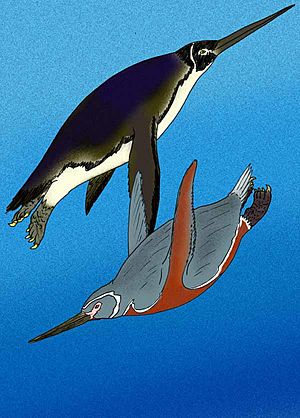Inkayacu facts for kids
Quick facts for kids Inkayacu |
|
|---|---|
 |
|
| Restorations of Inkayacu (below) and Icadyptes | |
| Scientific classification | |
| Genus: |
Inkayacu
|
| Species: |
paracasensis
|
Inkayacu (pronounced In-ka-YAH-koo) was a type of giant penguin that lived a very long time ago. It is now extinct, meaning it no longer exists. This amazing bird lived in what is now Peru about 36 million years ago, during a time called the Eocene epoch. Scientists found a nearly complete skeleton of Inkayacu in 2008. What was super cool about this discovery? It had fossilized feathers! These were the first fossil feathers ever found from a penguin.
Scientists studied tiny parts inside the feathers called melanosomes. These melanosomes are like tiny packets of pigment (color). The study showed that Inkayacu's feathers were likely gray or reddish-brown. This is different from most modern penguins. Today's penguins have dark black-brown feathers because their melanosomes are larger and shaped like tiny eggs.
Contents
What's in a Name?
The name Inkayacu comes from the Quechua language. This is a language spoken by the Inka people in South America. The word Inka means "emperor" or "king." The word yacu means "water." So, Inkayacu means "Water King."
The second part of its name, paracasensis, tells us where the fossils were found. They were discovered near Paracas in Peru.
How Inkayacu Looked
Even though Inkayacu lived a very long time ago, it looked a lot like penguins we see today. It had wings shaped like paddles, perfect for swimming. Its feathers were short, and it had a very long beak.
Inkayacu and other ancient penguins from Peru are often called "giant penguins." This is because they were much bigger than modern penguins. Inkayacu was one of the largest fossil penguins ever found. It was about 1.5 metres (4.9 ft) long. It weighed around 54.6–59.4 kilograms (120–131 lb). That's about twice as heavy as an average emperor penguin, which is the largest living penguin today!
Feather Colors and Melanosomes
The melanosomes in Inkayacu's feathers were long and thin. This is similar to what you find in most other birds. Their shape suggests that Inkayacu had gray and reddish-brown feathers all over its body.
Most modern penguins have melanosomes that are about the same length as Inkayacu's. However, they are much wider. There are also more of them inside the cells of living penguins' feathers. The shape of these melanosomes gives modern penguins their dark brown or black color. This is why modern penguins are mostly black and white.
Even without the special melanosomes of modern penguins, Inkayacus feathers were similar in many ways. Melanosomes help give feathers their color. They also make feathers stronger and more resistant to wear and tear. The feathers on Inkayacus body had large shafts. The main feathers along the edge of its wings were short and not very different from each other.
Discovery of the Water King
Scientists first found fossils of Inkayacu in 2008. They were discovered on the Pacific coast of the Ica in Peru. A team led by Rodolfo Salas uncovered a nearly complete skeleton. This happened in the Otuma Formation, which is part of the Paracas National Reserve.
A team led by Julia Clarke from the University of Texas studied the fossil. The researchers nicknamed the fossil "Pedro." This was the first time a fossil penguin was found with its feathers still attached! The feathers were so well preserved that scientists could study their melanosomes. This helped them learn about the tiny structures of ancient feathers.
Other large penguins, like Perudyptes devriesi and Icadyptes salasi, had been found in the same area the year before. The discovery of Inkayacu helped scientists understand more about how penguins evolved.
How Inkayacu Lived
Inkayacu lived in a sea that covered parts of Peru during the Late Eocene period. Its paddle-like wings meant it was a strong swimmer. It spent most of its life in the water.
Modern penguins have many tightly packed melanosomes in their feathers. These melanosomes make the feathers stronger. This strength helps them deal with the force of swimming underwater. Because Inkayacu had smaller and fewer melanosomes, it might not have been able to swim as deep. It might have stayed closer to the surface of the water.
However, it's also possible that the melanosomes in modern penguins don't just help with swimming. The feathers on the underside of living penguins are mostly white. These white feathers do not have the same dark, rigid melanin. If melanin was only for strength, all of a living penguin's feathers would likely be black.
See also
 In Spanish: Inkayacu para niños
In Spanish: Inkayacu para niños
- Dinosaur coloration


